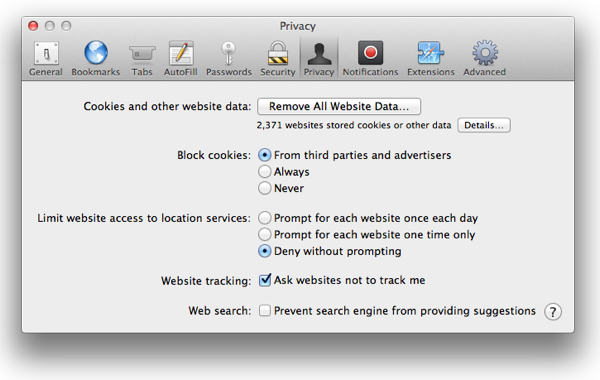What is Do Not Track, and why should you care?
Posted on
by
Peter James
Wondering what happened to Do Not Track in Safari? Read: Apple to remove “Do Not Track” feature from Safari
As you surf the web, web sites follow your every move. Through the use of “cookies” – files that record your actions – they can tell the last time you visited a site, what your user name is, whether you should be logged in automatically, and much more.
But some companies use shared cookies. Using these, big web advertising firms can follow your activity across different web sites. If the same company manages ads for many web sites, all they need to do is keep checking the same cookie to find which web sites you’ve visited, for how long, and which pages you’ve viewed. This is a way to build up a profile of your activities to serve ads targeted to your real-life use of the web.
While this has long been a privacy issue, it only got a foothold in 2009 when a group of security researchers proposed adding a “header” to web browsers saying when a user didn’t want to be tracked. This simply means that your browser, if you activate this setting, sends a short text (DNT: 1) every time you send a request to a web site to view a page. It’s simple and easy to use, but, of course, it depends on web sites – or, more correctly, advertisers – honoring it.
The Do Not Track idea gained traction in December, 2010, when the Federal Trade Commission (FTC) endorsed the use of this tool. Since then, most web browsers have adopted Do Not Track. In Apple’s Safari, under OS X 10.8 Mountain Lion, activating it is simple. From the Safari menu, choose Preferences, then click on the Privacy icon. Check Ask websites not to track me.

With Mac OS X 10.7 Lion, if you still have the older version of Safari, turning this setting on is not very obvious. Users must first turn on the Develop menu from the Advanced preferences, then choose the Send Do Not Track HTTP Header menu item to activate it.
It’s easy to turn this feature on in Firefox. Just go to the program’s Privacy preferences and check Tell websites I do not want to be tracked.

With Google Chrome, the process isn’t quite as simple. You need to install an extension, and there are many of them. Google’s own extension is called Keep My Opt-Outs, a rather cryptic name. Update, 2019: This extension is no longer available, and Do Not Track is now built into Google Chrome; go to chrome://settings/privacy and enable Send a “Do Not Track” request with your browsing traffic.
On the Windows side, Microsoft has announced that Do Not Track will be activated by default when the company releases Internet Explorer 10.
For now, there is no requirement that any web site comply with Do Not Track but legislation may impose this in the future. Unfortunately, most users are not aware of this feature, or of its implications. It is important to understand what advertisers do to monetize your web browsing and to push for restrictions, and Do Not Track is a simple workaround to this.